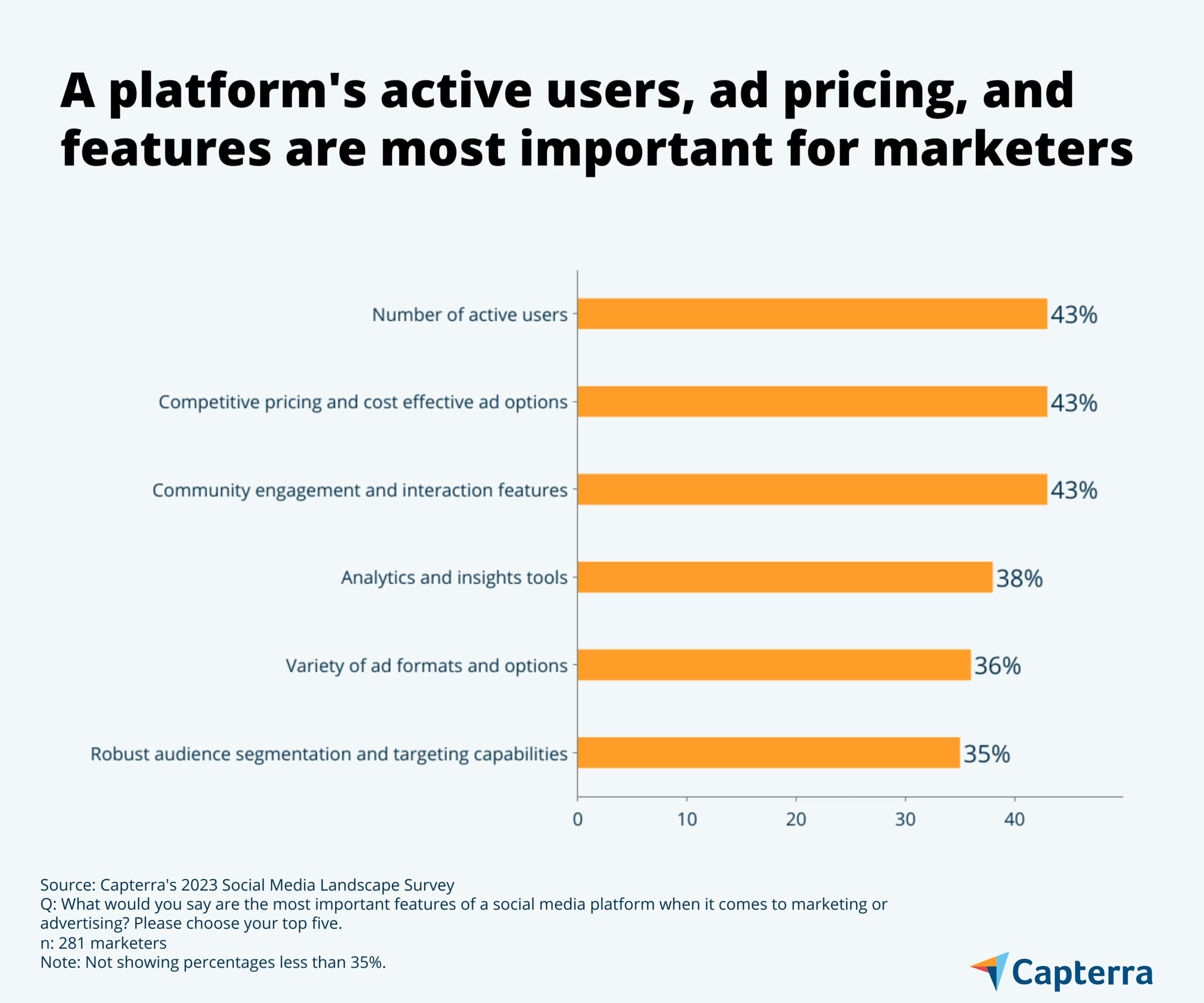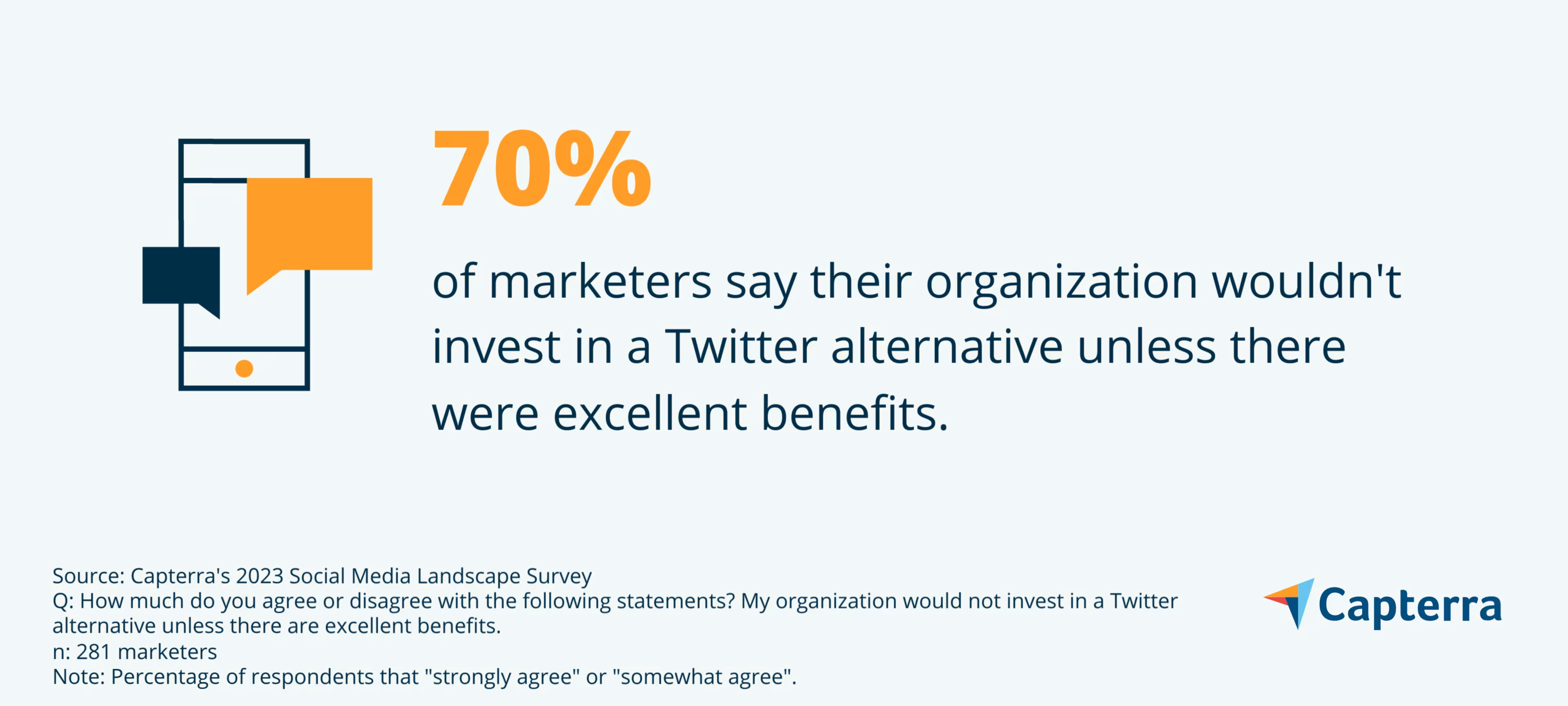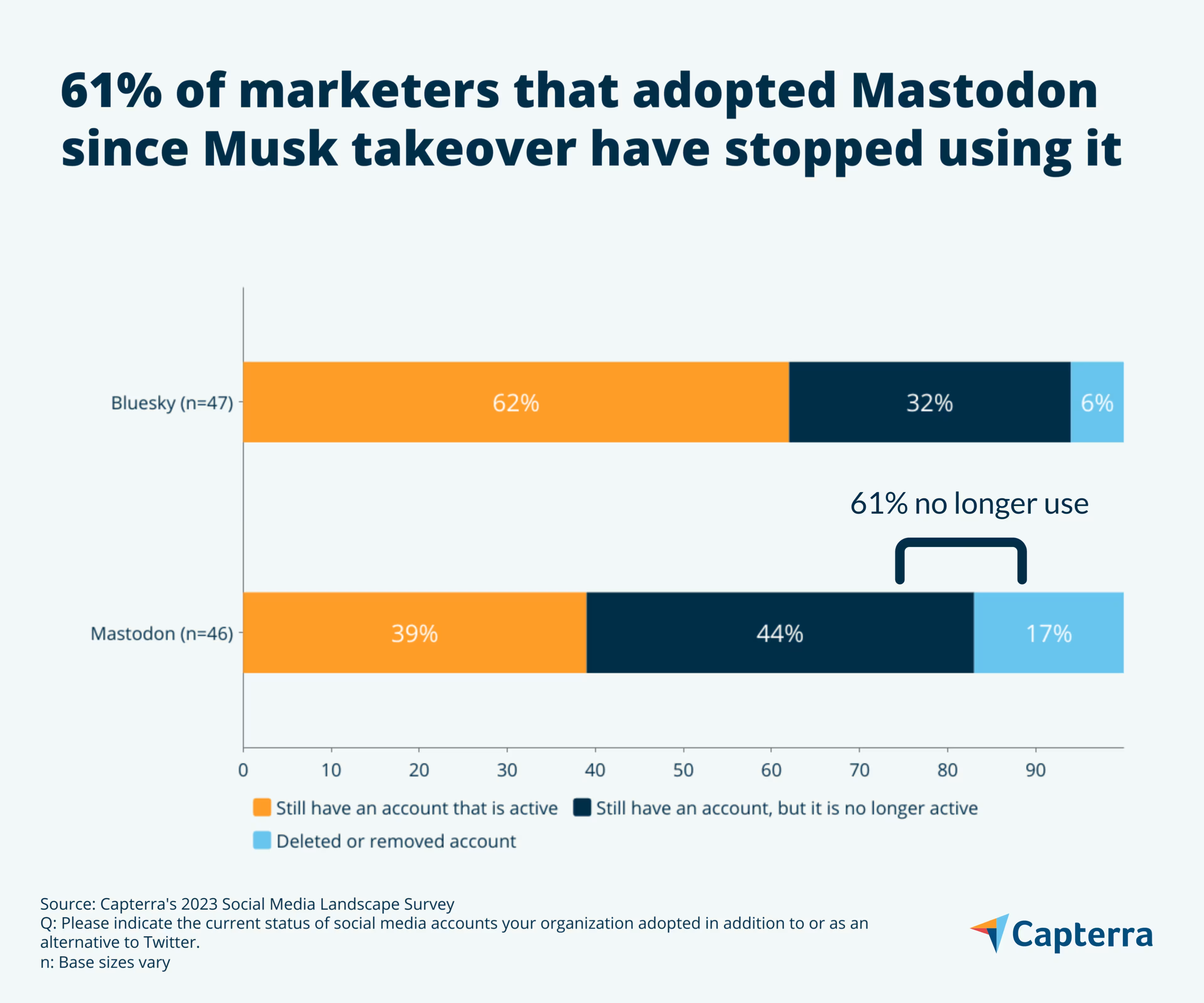70% of marketers would not invest in Twitter alternative unless there are excellent benefits.
In today's fragmented social media environment, marketers have to navigate a variety of platforms and decide which makes sense for their brand in order to optimize their budget and grab as much attention as possible.
Capterra's Social Media Landscape Survey (fielded in mid-July shortly after the app's launch) finds that among marketers with an X/Twitter or Instagram account, 80% say they are likely to try Threads for professional use. At the same time, 66% believe that it will ultimately make Instagram and Facebook weaker for marketing purposes.*
In this rapidly changing landscape, finding the right balance between established platforms and new contenders such as Threads is key to maximizing your brand's social media presence and growing your audience. Our data shows how many approaches can be successful in a post-social world if you invest with purpose, and it pinpoints what to look for when considering a new app, such as Threads.
/ Key findings
Marketers go where their audiences are, but how they allocate budget varies: 53% allocate resources fairly evenly across multiple platforms or apps, while 47% focus a significant portion of resources on one or two main platforms or apps.
Many marketers have returned to X/Twitter, or they never left it: 78% say their companies never paused or suspended ad campaigns, or that they are since back to what they were doing prior to Musk’s takeover of the platform.
Marketers look to their competitors when adopting new or emerging platforms: 40% say their organization will typically only try a new or emerging social media platform when they see their competitors use it successfully for marketing.
Marketers are drawn to Threads, but ultimately feel the app contributes to more fragmentation: Among those likely to create an account, 52% say it would be because it may have better user safety and security. However, 66% of marketers agree Threads will ultimately make Instagram and Facebook weaker for marketing or advertising.
One or many? Marketers have choices in the social media landscape
Twitter recently rebranded to "X" and TikTok continues to prompt talks of bans; meanwhile, new decentralized players such as Post, Bluesky, and Mastodon have entered the scene but have failed to gain mainstream traction.
As of July 2023, the launch of a new X/Twitter competitor called Threads has further complicated matters, leaving marketers to decide if it is worth it to exist on yet another app. The new platform from Meta allows users to share text-based posts and has gained over 100 million users in its first week.[1] Seventy-nine percent of marketers believe that consumers will react positively to the new app—however, it's reportedly already experiencing a drop in engagement and traffic among other issues such as spam attacks.[2] And a significant 66% of marketers agree that Threads will ultimately make Instagram and Facebook weaker for marketing or advertising.*
In the world of social media platforms, businesses and marketers follow their audiences wherever they may be. And with consumers spread across multiple social channels, marketers have adapted varied strategies for allocating their social media budgets.
Marketers say that when it comes to how their organization allocates resources, budget, or spending for social media advertising, 53% allocate resources fairly evenly across multiple platforms or apps while 47% focus a significant portion of resources on one or two main platforms or apps. This demonstrates a fairly even divide in the preferred approach to allocating resources.

The decision to allocate resources evenly or focus on one or two main platforms depends on factors such as company goals, available resources, platform features or dynamics, among other factors. Let's take a look at the pros and cons of each:
Pros and cons of evenly allocating resources
The pros of evenly allocating resources:
Wider reach: Allocating resources evenly allows you to reach a broader audience on multiple platforms and increase visibility. A platform's audience plays heavily into social media resource allocation. For example, companies that allocate resources mainly on one or two platforms, are more likely to select the number of active users as the most important draw (50%) compared to companies that diversify their resources across multiple platforms (38%).
Diversification: Investing in multiple platforms can help you reach certain users or gain access to specific features. Among companies that allocate resources fairly evenly across multiple social media platforms, we found that they are more likely to adopt new or emerging social media platforms as soon as they are released (25%) and report high value from them, compared to companies that stick to investing in one or two main platforms (14%). Spreading out resources on various platforms also reduces risk. If one platform undergoes changes or loses traction, your social media marketing efforts won’t be as impacted.
The cons of evenly allocating resources:
Resources spread thin: Allocating resources evenly may result in limited funds or time for each platform, potentially leading to less impactful campaigns.
Added complexity: The hassle of managing multiple platforms can be time-consuming and require an understanding of each platform’s unique dynamics, features, and audience.
Pros and cons of focusing on one or two main platforms
The pros of focusing on one or two main platforms:
Focused strategy: Concentrating resources allows for a more focused marketing approach. Similarly, it makes sense for businesses to have a presence on the big social media players that have larger and well established communities of users. The top social media platforms marketers say their companies are currently using are big social media giants such as Instagram (96%), Facebook (90%), YouTube (82%), X/Twitter (80%), and TikTok (71%).
Deeper engagement: By dedicating more resources on fewer platforms you can engage more effectively with your audience.
The cons of focusing on one or two main platforms:
Platform risks: If the main platforms your company focuses on undergo big changes or become volatile, it could heavily impact your social media marketing strategy.
Limited audience or missed opportunities: Focusing on specific platforms might mean you overlook potential opportunities or untapped audiences.
Stay curious…but not too curious
When experimenting with new or emerging social media platforms, such as Threads, our research finds that marketers are open to adopting new platforms (and many already have) but they need to have markedly positive benefits before investing their marketing budget.

The top reason marketers would consider investing in a new social media platform or app for marketing or advertising is to engage with new or potential customers (40%). Because each platform provides a varied user base, trying new platforms can provide opportunities to reach broader audiences.
Watching the competition
Ultimately, marketers follow their customers, but they also look to competitors when considering adding new social media platforms. Our research finds that 40% of marketers only like to try a promising new or emerging social media platform when they see competitors use it successfully for marketing.
Taking the time to observe how competitors position themselves on a new platform will help in crafting your strategy or differentiating yourself when adopting platforms at your own business. Additionally, a third of marketers say their companies only like to try new platforms when a large enough portion of customers are using it.
Over time, most new platforms will mature in features (including advertising tools) as well as develop established audiences leading to more effective campaigns. However, it's important to remain cautious with social media investments. For instance, with Threads, it's difficult to foresee where the app's audience will land as developers continue to work on refining features and performance. Firms have reported usage dropping after its initial launch demonstrating that the app may be losing some momentum.[2] And now with Musk continuing to rehaul X and TikTok adding text-only posts, Threads, more than ever, needs to deliver traffic in order to be truly valuable to marketers.[3],[4]
Marketers say decentralized platforms are attractive, but challenging
Traditional social media platforms are far from perfect; a possible way forward is decentralization. As concerns around privacy and data security continue to rise, there's been a trend of users moving into more secure or decentralized social spaces.
What is decentralized social media?
Decentralized social networks are built on independently run servers rather than one centralized server owned by a business. Mastodon and Bluesky are examples of decentralized social networks that are based on open sourced software and function a lot like X/Twitter.
Threads is attempting to head in this direction, stating, "we're working to soon make Threads compatible with the open, interoperable social networks that we believe can shape the future of the Internet." This will help brands better distribute their content with the ability to interact with users from other apps and sources.
And with marketers still concerned with the direction X/Twitter is heading, could decentralization be the future for social networks? Our research finds that 80% of marketers say they are at least somewhat familiar with the term decentralized social media, and 98% of those marketers believe decentralization is moderately or very important when it comes to social media for business. However, there are challenges.
Decentralized platforms are only starting to gain traction and don't yet have the number of active users that the big social media players have. Furthermore, everyday users find them difficult to understand and overly complex (especially when creating new accounts). Even among tech-savvy marketers, many that have adopted decentralized platforms in addition to or as an alternative to X/Twitter have since stopped using them.

Have marketers returned to X or have they gone to decentralized platforms?
Since Musk's X takeover in October 2022, a majority of marketers say that their companies have experimented with new platforms. For example, 69% say their business has used or created an account on an emerging social media platform as either an addition or alternative to X. Many said they adopted platforms such as Discord (45%), Clubhouse (29%), and Post (25%).
Nonetheless, 35% of marketers that said their company had paused advertising on X after Musk's takeover have already returned to their previous levels. Another 43% say their company never paused or suspended ad campaigns at all, indicating that they are willing to see through disruptions and uncertainty.
(Please note that this research was conducted prior to Twitter’s recent rebranding to X.)
How to determine if Threads is right for you
If your business has been looking at investing in different social media platforms and is specifically considering adopting Threads, below are some key questions to consider. You can also take these questions into consideration when looking into other platforms as well.
Is your business equipped to manage yet another platform?
With any new app, such as Threads, it's difficult to gather clear metrics on the user base or have a solid understanding of all the features as they evolve. Using social media analytics tools can help you track all of your social media accounts in one centralized location, making it simple to manage and track multiple platforms.
Will Threads deliver on safety and security?
Eighty percent of marketers said they were extremely or very likely to adopt Threads. Among them, respondents said the top reasons why they would be open to creating an account is because it may have better user safety and security (57%), better content moderation (53%), and better leadership decisions (51%).
Threads claims to enforce the same Community Guidelines as Instagram. However, marketers might have to wait until more users join the app to see content moderation practices at work.
Is there a feature you need or are you jumping on a trend?
When we showed marketers a list of potential features for the app, nearly a third felt that the ability to control replies and mentions and easily block or report spam would be the most important feature for their business when it comes to accomplishing marketing or advertising objectives.
We are still in the early days of the app's development so it's expected that Threads will face some continued challenges. Marketers must first assess whether or not it adds value and effectiveness for their companies. Despite the urge to jump on much-hyped trends, allow yourself ample time to vet new social media platforms before joining. It's okay to experiment, but don't overcommit.
If you like this report, check out these additional marketing resources:

